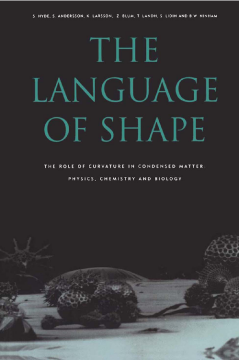
BOOK
The Language of Shape
S. Hyde | Z. Blum | T. Landh | S. Lidin | B.W. Ninham | S. Andersson | K. Larsson
(1996)
Additional Information
Book Details
Abstract
This book develops the thesis that structure and function in a variety of condensed systems - from the atomic assemblies in inorganic frameworks and organic molecules, through molecular self-assemblies to proteins - can be unified when curvature and surface geometry are taken together with molecular shape and forces. An astonishing variety of synthetic and biological assemblies can be accurately modelled and understood in terms of hyperbolic surfaces, whose richness and beauty are only now being revealed by applied mathematicians, physicists, chemists and crystallographers. These surfaces, often close to periodic minimal surfaces, weave and twist through space, carving out interconnected labyrinths whose range of topologies and symmetries challenge the imaginative powers.
The book offers an overview of these structures and structural transformations, convincingly demonstrating their ubiquity in covalent frameworks from zeolites used for cracking oil and pollution control to enzymes and structural proteins, thermotropic and lyotropic bicontinuous mesophases formed by surfactants, detergents and lipids, synthetic block copolymer and protein networks, as well as biological cell assemblies, from muscles to membranes in prokaryotic and eukaryotic cells. The relation between structure and function is analysed in terms of the previously neglected hidden variables of curvature and topology. Thus, the catalytic activity of zeolites and enzymes, the superior material properties of interpenetrating networks in microstructured polymer composites, the transport requirements in cells, the transmission of nerve signals and the folding of DNA can be more easily understood in the light of this.
The text is liberally sprinkled with figures and colour plates, making it accessible to both the beginning graduate student and researchers in condensed matter physics and chemistry, mineralogists, crystallographers and biologists.
